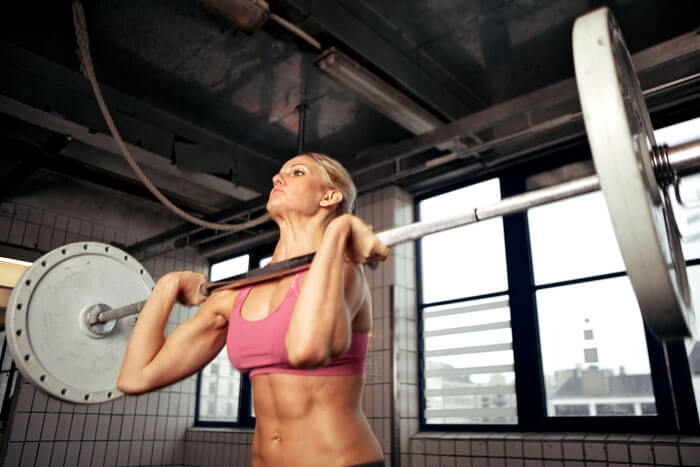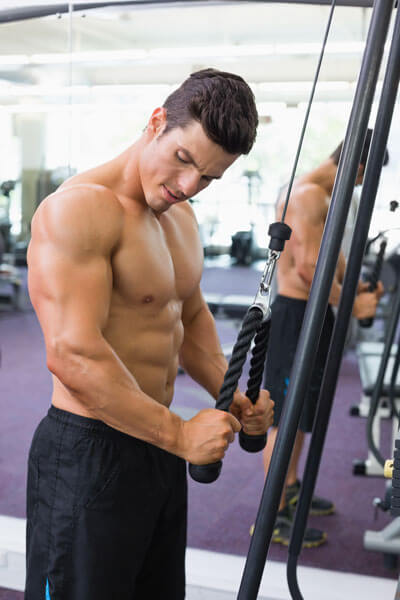Do you know the secret behind the superset?
Hang around the weight rack long enough and you’ll hear talk about these calorie-shredding workouts that create huge muscle gains in half-time.
What is a superset?
It’s performing two exercises in a row with little to no rest between. For example, doing a set of curls followed by a set of tricep extensions. Or squats followed by leg extensions.
There are many ways to perform a superset. Many ways exist to hack your workouts to save time and create more muscle – fast!
Step into the gym with us as we explore the differences between superset techniques, which types of supersets are right for you and how to incur huge gains – while keeping a balanced, healthy physique.
Why are Supersets Effective?
Supersets work because they are required your body to work harder for longer. Without rest between stresses, the body is required to perform at a higher level. Increasing the overall workload and volume of each workout leads to serious muscle and strength development in reduced time. When done to the max, supersets result in complete muscle failure.
Supersets enable you to:
- Increase workout intensity and calorie burning without changing exercises
- Increase focus
- Increase and prolong blood flow to muscles (increasing oxygen and nutrients for hypertrophy later)
- Enhance muscle-building potential
- Hyper-target muscle groups for growth
- Add cardio intensity during weightlifting
- Save time in the gym

Supersets ramp up the metabolic stress during a training session and target muscle groups for faster gains. Decreased recovery time elevates anabolic hormone response during and after exercises, bringing you one step closer to your goals.
Heavy loads paired with less rest increase circulating levels of lactate in your blood. This raises overall blood acidity, which triggers the release of growth hormone (HGH) from the endocrine system, most notably the pituitary gland in the brain.
Many bodybuilders use this science to rise above plateaus and advance hypertrophy (muscle building) to new levels. This is key, as muscles become accustomed to repeated stresses and promoting growth is increasingly difficult as time passes.
Because supersets shock muscles that are used to a set pattern of strain, they are a direct route to more muscle growth. Give yourself time to adjust to the intensity of these new workouts – they can be very tiring before developing the necessary endurance.
Now let’s look at the different superset types you can perform.
What is a Antagonistic Superset?
The body is composed of pairs of opposing, or antagonistic, muscle groups that function in different ways from another. For example, your arms contain the antagonistic biceps and triceps while your torso is composed of the antagonistic chest and back muscles.
Antagonistic supersets are doing an exercise for one body part and then immediately doing a set of the antagonistic body part.
The idea is to improve recovery potential by increasing total blood flow to a general area, thereby increase the amount of weight you can lift.
By stressing a nearby muscle groups, blood flow to the working muscle is increased while resting between sets. Keeping the circulation localized boosts workout capabilities while improving muscle-building processes after workouts.
Here’s an example antagonistic superset:
- Pull Ups (3 sets of 10)
- Bench Press (3 sets of 10)
Rest 90-120 seconds between each superset of pull ups and bench. Increase weight as reps progress. Allow muscles to recover the minimal amount while working the other, maintaining the blood flow to the area being worked.
Or for legs, try this:
- Deadlifts (4 sets of 10)
- Front Squats (4 sets of 6)
Always complete your posterior-chain exercises before anterior-chain exercises. Completing the pull motion will enhance the power in the push motion that follows.

Posterior-chain simply means back-of-body muscles, such as the glutes, traps, erector spinae muscles along the spine, etc. When you perform a deadlift, pull up, squat, bent over row – you target the posterior (back) of the body.
Posterior-chain muscles in the torso require a pulling motion. When located at or below the waist, posterior-chain muscles necessitate hip flexion.
Anterior-chain groups are what’s known as “beach muscles.” Front-side muscles like abs, chest, shoulders, quads and biceps are the most frequently targeted for growth because of their outward appearance. Over-development of the front imbalances posterior-chain muscles compromising stability and muscle balance.
A set of rows before a bench press session can go a long way towards stabilizing the shoulder. This will lengthen the pecs and assist in maintaining proper posture. Doing pulling motions and flexion-based movements can help improve fluid motion and balance out the body for better performance.
Doing such activities in reverse can promote a faulty muscle recruitment pattern and inflame any existing muscle imbalances.
Pull before you push to save the hips and shoulders.
What is an Agonist Superset?
While antagonist supersets work different muscle groups, agonists supersets target the same muscle group. This type of action doubles down on the muscles, really making them burn but getting real results. There are also a variety of ways to structure your agonist supersets, depending upon your weightlifting goals.
For upper body, your agonist sets could be:
- Tricep Extensions (4 sets of 10)
- Close-Grip Bench (4 sets of 10)
Alternating between tricep extensions and an immediate set of close grip bench will fry the triceps while also giving the chest a good pump.
Or for legs, try:
- Deadlifts (4 sets of 10)
- Hamstring Curls (4 sets of 10)
Unlike antagonist supersets, you want to minimize rest time between agonist sets. The goal here is make the muscles work til exhaustion and prompt massive hypertrophy. Be sure to take 90-120 seconds between agonist supersets to recover.

Pre-Exhaustion Agonist Supersets
Also called isolation or compound supersetting, pre-exhaust supersets are incredible for targeting a specific muscle area. Do an isolation exercise – such as a dumbbell fly – immediately followed by a compound exercise – like bench press.
This is used for targeting lagging body parts. By starting on the smaller, isolated muscle group, you make it work doubly hard in the superset with the large muscle group.
You could do bicep curls followed by pull ups for insane bicep growth. Or leg extensions right before squats to hammer the quads.
Do pre-exhaust sets to recruit more muscle fibers for use during compound movements and really tax your stronger muscle groups while shredding the isolation areas.
Post-Exhaustion Agonist Supersets
This is the opposite of pre-exhaust superset, so you begin with the larger muscle group and immediately do a set of an isolated muscle group.
For example, do deadlifts directly before a leg curl.
Take this approach to focus upon a single isolated muscle area, such as the hamstrings, in a different way from pre-exhaust sets. These have the benefit of being safer, as they don’t leave you performing load-bearing compound exercise near the point of exhaustion. Where these excel is doubling-down on isolation movement muscle groups.
Experiment between pre-and post-exhaust sets to see which work best for you. A truly diversified, shocking workout routine will incorporate both styles of exhaustive supersets.
What is a Non-Competing Superset?
Non-competing supersets are often called upper-lower supersets because you combine the time-saving benefits of leg and torso workouts together. If you want to hit a full body workout but have little time, non-competing supersets are for you.
The benefits of non-compete sets is that you can invoke the power of a low-body push – like leg press – and balance out the compressive force with a upper body pull – such as pull ups.
Try these non-competing supersets:
- Deadlifts and Pulldowns
- Squats and Pull Ups
- Bent-over Row and Parallel Bar Dips
- Standing Press and Hanging Leg Raises
- Sit Ups and Cable Pullovers
Do your compressive and anterior-chain push motion first. You’ll use following torso movements to decompress the back, which helps prevent injury and pain while improving range of motion. A major risk of supersetting is overcompensating vertebral segments, so use your programming to build muscle and stay healthy.
What to Remember When Creating a Superset Program:
- Supersets aren’t fast and furious and not done for time. Moving needlessly fast between sets compromises form and can lead to injury.
- Poorly programmed supersets can lead to muscle trauma and overuse, overtraining soft tissues and compromising good form.
- Perform posterior-chain exercises before anterior-chain exercises for maximum performance.
- Combine compressional movements with decompression movements to save your back from pain and injury.
- Don’t pre-fatigue stabilizing muscles. Avoid overstraining the core or the low back. Supersetting compound movements that utilize the core – like squats or deadlifts – with an ab-roller or crunches routine comprises core strength in a way that can lead to injury.
- Use spotters if you’re performing exhaustive sets. Small muscle groups – like triceps – are quick to fail during the final sets of bench.
- Do not superset small, supporting muscles that aid with exercises unless you do them second. Do not to tricep pushdowns and then bench-press, because the tricep fatigue will limit the quality of your bench press. The result is underutilized pec muscles. Do the bench first and then the pushdowns.
The Final Set
This has been your guide to supersetting your way to more muscle gains. When starting out with supersets, start slow and expect to get exhausted easily. Whether you’re performing antagonistic supersets to boost muscle gains, or targeting specific muscles with agonistic sets for focused development, be sure to balance your physique and minimize strain upon the body. Practice decompressive sets and avoid pre-fatigue in the low back and core muscles that are needed for stability. Prepare yourself to push to complete muscle failure. It’s going to hurt – but it’s guaranteed to get results.


